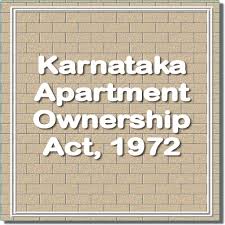As rapid urbanization started gripping the country fervently, there was a widespread need and demand for land in urban areas which paved the way for the growth of flats/apartments due to a dearth of land to satisfy every individual need. With this, also came the need to regulate and protect the interests of flat/apartment owners.
To assuage the fears of home owners and to regulate the workings of the apartment/flat associations, the Karnataka Legislature enacted the Karnataka Apartment Ownership Act or ‘KAOA’ for short, on 23rd July 1973 with the all pervasive objective of ensuring that each apartment constitutes a heritable and transferable immoveable property and each apartment
owner has an undivided interest/share in the apartment .The operative word in the KAOA being ‘undivided share’ in not just the apartment an individual owns but also in the common areas/facilities collectively held by all individuals.
Salient features of Karnataka Apartment Ownership Act, 1972
- The KAOA applies only to residential properties. Furthermore, a building has been defined under the Act as a part of the property containing 4 or more apartments, or 2 or more building each containing 2 or more apartments with a total of 4 or more apartments.
2.An apartment owner submits his apartment to the provisions of the Act by executing a Deed of Declaration.
- The KAOA creates a heritable and transferable right in the immoveable property together with an undivided interest in the common areas/facilities.
- The KAOA further provides that the apartment owner is entitled to an undivided share in the common areas and facilities. This share is determined and computed by taking the value of the apartment in relation to the value of the property which is expressly mentioned in the Deed of Declaration. Furthermore, it prohibits any apartment owner to bring any action for partition with respect to the common areas/facilities.
- Each apartment owner who becomes a part of the Deed of Declaration under the KAOA shall also comply with the bye laws formed by each apartment owners association. These bye laws serve as a rule book to help guide the apartment owner association to administer.
- The KAOA envisages and details a Deed of Declaration or ‘DOD’ and a Deed of Apartment or ‘DOA’ more commonly understood as the sale deed of an apartment owner. The DOD is an elaborate document containing various details pertaining to the entire property, like description of the land on which the building exists, number of apartments, total built up area, super built up area, common areas and facilities, percentage of undivided share in the property.
- The administration and running of each apartment shall be guided by a set of bye laws, a copy of which has to be annexed with the DOD which contain details as to how elections are to be conducted, how apartment owners association members are to be elected, quorum of members for a majority, amendment of the bye laws, among other things so necessary for the functioning of the apartment collectively.
Critical Analysis of the Karnataka Apartment Ownership Act, 1972
The KAOA, 1972 is one of the foremost legislations in the country after the Maharashtra Apartment Ownership Act, 1970 to deal with apartments and the concept of undivided share/right/interest
An apartment owner acquires rights on the purchase of a flat/apartment in the following 3 ways-
- Undivided interest in the land
- Carpet area of the flat/apartment
- Proportionate interest in the common areas
The intent of the legislature to enact the KAOA was to make each apartment inheritable and transferable. Each apartment owner thus has the right of a proportionate interest in the common areas/facilities.
The key highlights of the KAOA is the mention of the undivided interest or share in the individual apartment together with the undivided interest in the common areas/ facilities in the sale deed of each individual apartment owner. By virtue, this makes the apartment owner an absolute owner with a clear title and ownership. Thus an owner can transfer his immoveable property, along with the undivided share in terms of percentage by any mode as would apply to any transfer and succession of immovable property under the Transfer of Property Act, 1882.
With apartments mushrooming in every corner of Bangalore, catering to all sections and classes of people, the KAOA has stood the test of time since its inception in 1973. With more and more people choosing to move into apartments for various reasons, the scope of KAOA with this regard still remains limited.
The lack of knowledge, unavailability of information and to an extent misconceptions surrounding the KAOA has contributed to many apartment owners opting to register their apartments and submit their apartments under the Karnataka Societies Registration Act, 1960 as compared to the KAOA which is deemed to be cumbersome and tedious.
Thus, a lot needs to be done and achieved to make apartment owners and potential apartment owners to be made aware of the KAOA and of their rights enunciated under the Act.


.jpg)



Leave a Reply
Your email address will not be published. Required fields are marked*